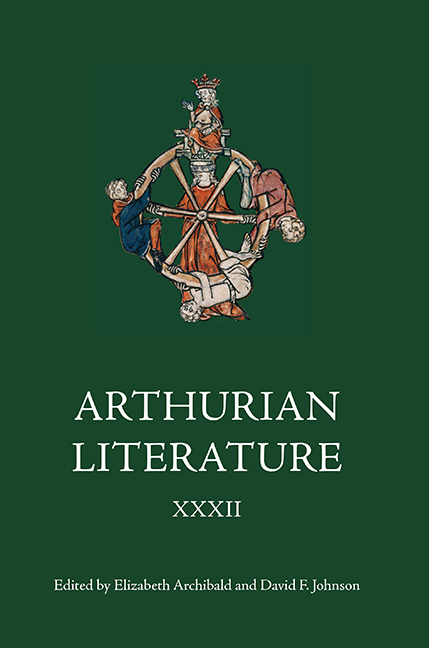Book contents
- Frontmatter
- Contents
- List of Illustrations
- General Editors’ Foreword
- List of Contributors
- I Wounded Bodies: Kingship, National Identity and Illegitimate Torture in the English Arthurian Tradition
- II The Place of Emotion: Space, Silence and Interiority in the Stanzaic Morte Arthur
- III Another Source for Malory’s ‘Tale of Sir Gareth’
- IV ‘Warre and Worshyppe’: Depictions of Battle in Malory’s Le Morte Darthur
- V Malory’s ‘Chivalric Cliques’: Public and Private Felyshyp in the Arthurian Community
- VI Scribal Modifications to Concluding Formulae in the Winchester Manuscript
- VII Heraldic Imagery in the Embroidered Tristan Narratives
- VIII Update to the List of Manuscripts of Geoffrey of Monmouth’s Historia Regum Britanniae
- Contents of Previous Volumes
II - The Place of Emotion: Space, Silence and Interiority in the Stanzaic Morte Arthur
Published online by Cambridge University Press: 11 May 2021
- Frontmatter
- Contents
- List of Illustrations
- General Editors’ Foreword
- List of Contributors
- I Wounded Bodies: Kingship, National Identity and Illegitimate Torture in the English Arthurian Tradition
- II The Place of Emotion: Space, Silence and Interiority in the Stanzaic Morte Arthur
- III Another Source for Malory’s ‘Tale of Sir Gareth’
- IV ‘Warre and Worshyppe’: Depictions of Battle in Malory’s Le Morte Darthur
- V Malory’s ‘Chivalric Cliques’: Public and Private Felyshyp in the Arthurian Community
- VI Scribal Modifications to Concluding Formulae in the Winchester Manuscript
- VII Heraldic Imagery in the Embroidered Tristan Narratives
- VIII Update to the List of Manuscripts of Geoffrey of Monmouth’s Historia Regum Britanniae
- Contents of Previous Volumes
Summary
The Stanzaic Morte Arthur (hereafter SMA) has always had a rather mixed press, and scholars have by turns emphasised its clumsiness and its artistic success. Writing in 1978, Sherron E. Knopp speaks of ‘glaring disagreement over the poem's strengths and weaknesses’, observing how ‘faults in the eyes of one critic become merits in the eyes of another, and vice versa’. Knopp concludes that ‘in the end one begins to wonder whether everyone has read the same poem’. Despite the publication of a number of perceptive studies in the meantime, this is still an essentially accurate picture of the poem's reputation nearly forty years on, and the SMA remains largely neglected in recent criticism. This may be due to the poem's uncomfortable position in the chronology of medieval Arthuriana, stuck between two major canonical works: the French Mort Artu from the Vulgate cycle, which is its source, and Malory's Morte Darthur, which uses both the French Mort and the SMA as sources in turn. The poem's relationship to these two major monuments of the Arthurian canon threatens to dwarf the achievements of the SMA itself, and furthermore makes it difficult to encounter the poem on its own terms. Even Donald Kennedy's perceptive analysis of the portrayal of Arthur in the poem evokes J. D. Burnley's familiar model of ‘cultural descent’ associated with popularising English translations of French courtly romances.
The recent explosion of interest in Middle English popular romances has enabled criticism to move beyond such rigid, vertical models of relationship, and has provided a useful critique of unexamined, essentialist notions like literary subtlety, artistry and sophistication: such notions are invariably postulated on circular reasoning, and perpetuate deeply entrenched assumptions about artistic value and cultural legitimacy beneath the invocation of ostensibly innocent, purely aesthetic criteria. Curiously, however, the SMA seems to have benefited very little from this recuperative turn towards cultural history in the study of Middle English romance, perhaps because it has no marvels, Saracens, princesses, monsters or otherwise exuberant plot developments to captivate its readers.
- Type
- Chapter
- Information
- Arthurian Literature XXXII , pp. 31 - 58Publisher: Boydell & BrewerPrint publication year: 2015



